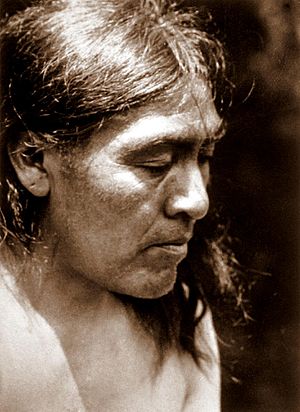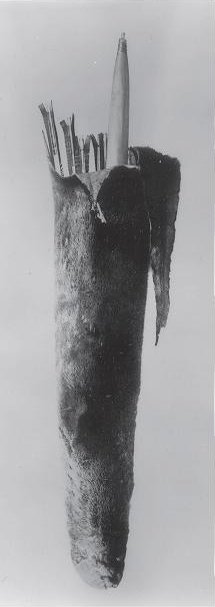Ishi facts for kids
Quick facts for kids
Ishi
|
|
|---|---|
 |
|
| Born | Unknown (first documented in 1865) Northern California Sierra Foothills, U.S.
|
| Died | March 25, 1916 (age 55–56) |
Ishi (born around 1861 – died March 25, 1916) was the last known member of the Yahi people. They were a Native American group from California in the United States. Most of the Yahi, and many from their larger tribe, the Yana, were killed in the 1800s.
Ishi lived most of his life hidden from modern American culture. In 1911, when he was about 50 years old, he appeared near Lassen Peak in Northern California.
Ishi means "man" in the Yana language. This was a name given to him by others. In Yahi culture, people did not say their own name until someone else introduced them. When asked his name, Ishi said, "I have none, because there were no people to name me." This meant no other Yahi person was left to introduce him.
Experts in studying human cultures, called anthropologists, at the University of California, Berkeley, took Ishi in. They learned from him and also hired him to work as a janitor. He lived for about five years in a university building in San Francisco. Many films and books have told his life story. A famous book about him is Ishi in Two Worlds, written by Theodora Kroeber in 1961.
Contents
Ishi's Life Story
Growing Up Hidden
In 1865, Ishi and his family were attacked in what is known as the Three Knolls Massacre. About 40 people from their tribe were killed. While 33 Yahi managed to escape, ranchers later killed about half of those survivors.
The last few survivors, including Ishi and his family, went into hiding. They stayed hidden for the next 44 years. Before the California Gold Rush (1848–1855), there were about 404 Yahi people. The larger Yana group had about 2,997 people.
The Gold Rush brought many miners and settlers to northern California. This put a lot of pressure on the native groups. Gold mining polluted the water and killed fish. Deer, a food source, left the area. Settlers also brought new diseases like smallpox and measles.
The northern Yana group died out, and the Yahi population dropped greatly. Because they needed food, the Yahi sometimes clashed with settlers. Settlers offered rewards for killing native people. In 1865, settlers attacked the Yahi while they were sleeping.
After this attack, Ishi's entire group, the Yana/Yahi, may have been reduced to about sixty people. From 1859 to 1911, Ishi's small group mixed more with other Native American groups. These included the Wintun, Nomlaki, and Pit River members.
In 1908, a group of surveyors found Ishi's camp. It had two men, a middle-aged woman, and an elderly woman. These were Ishi, his uncle, his younger sister, and his mother. Three of them ran away. The old woman hid because she was sick. The surveyors stole from the camp. Ishi's mother died soon after he returned. His sister and uncle were never seen again.
Stepping into the Modern World
After the 1908 attack, Ishi spent three more years living alone in the wild. He was starving. On August 29, 1911, Ishi was found near Oroville, California. He was trying to find meat after forest fires in the area.
The local sheriff took Ishi in to keep him safe. This "wild man" caught the attention of many people. Professors from the University of California, Berkeley, Museum of Anthropology heard about him. This museum is now called the Phoebe A. Hearst Museum of Anthropology (PAHMA). They brought him to the university.
Ishi was studied by the university experts. He also worked as a janitor. He lived in an apartment at the museum for most of his last five years. In June 1915, he lived in Berkeley with the anthropologist Thomas Talbot Waterman and his family.
Waterman and Alfred L. Kroeber, who was the museum director, studied Ishi closely. They talked with him for a long time. They wanted to learn about Yahi culture. Ishi described families, Yahi names, and ceremonies he knew. Much of his people's traditions had been lost. This was because there were few older people left in his group.
Ishi taught his native Yana language. A language expert, called a linguist, named Edward Sapir, recorded and studied it. Sapir had already studied other Yana languages.
Ishi died from a lung disease called tuberculosis on March 25, 1916. It is said his last words were "You stay. I go." His friends at the university tried to stop doctors from doing an autopsy on Ishi's body. Yahi tradition said the body should stay in one piece. But doctors at the University of California medical school performed the autopsy before Waterman could stop them.
Ishi's brain was kept, and his body was cremated. Kroeber put Ishi's preserved brain in a Pueblo Indian pottery jar. He wrapped it in deer skin. He sent it to the Smithsonian Institution in 1917. On August 10, 2000, the Smithsonian returned it to the descendants of the Redding Rancheria and Pit River tribes. This happened because of a law called the National Museum of the American Indian Act of 1989.
According to Robert Fri, director of the National Museum of Natural History, "Ishi was not the last of his kind." He explained that Ishi's closest living relatives are the Yana people of northern California. Ishi's other remains were also returned. The tribal members planned to bury them in a secret place.
Ishi's Impact and Recognition
- Ishi is highly respected by people who make stone tools, called flintknappers. He was one of the last Native Americans to make tools from stone in North America. His methods are copied by many toolmakers today.
- Recordings of Ishi speaking, singing, and telling stories were made on 148 wax cylinders. These recordings, lasting over five hours, were chosen by the Library of Congress. They were added to the National Recording Registry in 2010. This list includes recordings that are important for culture, history, or art.
- The Ishi Wilderness Area in northeastern California is named after him. This area is believed to be where his tribe lived long ago.
- A very large giant sequoia tree, found in 1993, is named Ishi Giant in his honor.
- In 1999, anthropologists at the University of California, Berkeley, wrote a letter. They apologized for how Ishi was treated.
Ishi in Books and Movies
Ishi's story has been told in many ways:
Films
- Ishi: The Last of His Tribe (1978) was a TV movie with Eloy Casados playing Ishi.
- The Last of His Tribe (1992) was another TV movie, with Graham Greene as Ishi.
- Ishi: The Last Yahi (1992) is a documentary film by Jed Riffe.
Literature
- Lawrence Holcomb wrote a novel called The Last Yahi: A Novel About Ishi (2000).
- Theodora Kroeber's book, Ishi in Two Worlds (1961), is a popular story of Ishi's life. She also wrote Ishi: Last of His Tribe (1964), a fictionalized version for younger readers.
Images for kids
See also
 In Spanish: Ishi para niños
In Spanish: Ishi para niños






